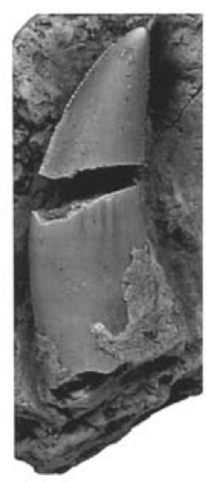Avalonia (dinosaur) on:
[Wikipedia]
[Google]
[Amazon]
 ''Avalonianus'' is a highly dubious and possibly invalid genus of
''Avalonianus'' is a highly dubious and possibly invalid genus of Go to ''Camelotia''
for more information The only sufficient remains attributable to ''Avalonianus'' are several now lost fossil teeth from the chimera that were referred to Archosauria.
 ''Avalonianus'' is a highly dubious and possibly invalid genus of
''Avalonianus'' is a highly dubious and possibly invalid genus of archosaur
Archosauria () is a clade of diapsids, with birds and crocodilians as the only living representatives. Archosaurs are broadly classified as reptiles, in the cladistic sense of the term which includes birds. Extinct archosaurs include non-avian d ...
from the Late Triassic
The Late Triassic is the third and final epoch (geology), epoch of the Triassic geologic time scale, Period in the geologic time scale, spanning the time between annum, Ma and Ma (million years ago). It is preceded by the Middle Triassic Epoch ...
of England
England is a country that is part of the United Kingdom. It shares land borders with Wales to its west and Scotland to its north. The Irish Sea lies northwest and the Celtic Sea to the southwest. It is separated from continental Europe b ...
. It was first described in 1898 by Harry Seeley
Harry Govier Seeley (18 February 1839 – 8 January 1909) was a British paleontologist.
Early life
Seeley was born in London on 18 February 1839, the second son of Richard Hovill Seeley, a goldsmith, and his second wife Mary Govier. When his fat ...
with the name ''Avalonia'',H. G. Seeley. 1898. On large terrestrial saurians from the Rhaetic Beds of Wedmore Hill, described as ''Avalonia sanfordi'' and ''Picrodon
''Picrodon'' is the name given to a genus of archosaur, possibly a sauropodomorph dinosaur, from the Rhaetian of England which was possibly synonymous with the dubious archosaur ''Avalonianus''. The type, and only species, ''P. herveyi'', was n ...
herveyi''. Geological Magazine, decade 4 5:1-6 but that name was preoccupied (Walcott, 1889), so Oskar Kuhn
Oskar Kuhn (7 March 1908, Munich – 1990) was a German palaeontologist.
Life and career
Kuhn was educated in Dinkelsbühl and Bamberg and then studied natural science, specialising in geology and paleontology, at the University of Munich, fr ...
renamed it in 1961, albeit with no epithet (although Seeley added the epithet ''sanfordi'' in 1898). It was thought to be a prosauropod
Sauropodomorpha ( ; from Greek, meaning "lizard-footed forms") is an extinct clade of long-necked, herbivorous, saurischian dinosaurs that includes the sauropods and their ancestral relatives. Sauropods generally grew to very large sizes, had lon ...
, but later analysis revealed it was actually a chimera
Chimera, Chimaera, or Chimaira (Greek for " she-goat") originally referred to:
* Chimera (mythology), a fire-breathing monster of Ancient Lycia said to combine parts from multiple animals
* Mount Chimaera, a fire-spewing region of Lycia or Cilicia ...
, with the original teeth coming from a non-dinosaurian ornithosuchian (or possibly an early theropod
Theropoda (; ), whose members are known as theropods, is a dinosaur clade that is characterized by hollow bones and three toes and claws on each limb. Theropods are generally classed as a group of saurischian dinosaurs. They were ancestrally c ...
), and later-referred post-cranial prosauropod remains (which were renamed '' Camelotia'').for more information The only sufficient remains attributable to ''Avalonianus'' are several now lost fossil teeth from the chimera that were referred to Archosauria.
References
Prehistoric archosaurs Late Triassic reptiles of Europe Paleontological chimeras Fossil taxa described in 1961 {{paleo-archosaur-stub